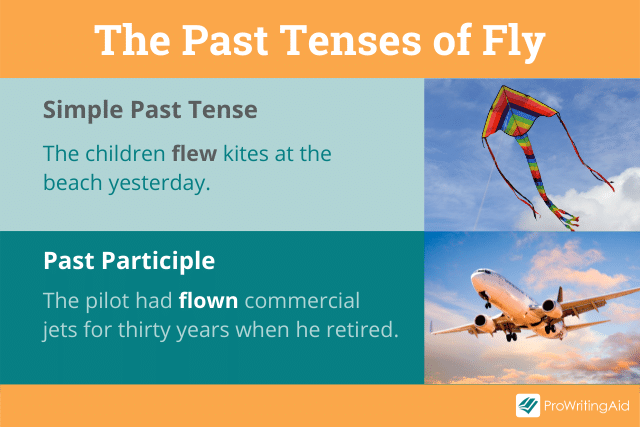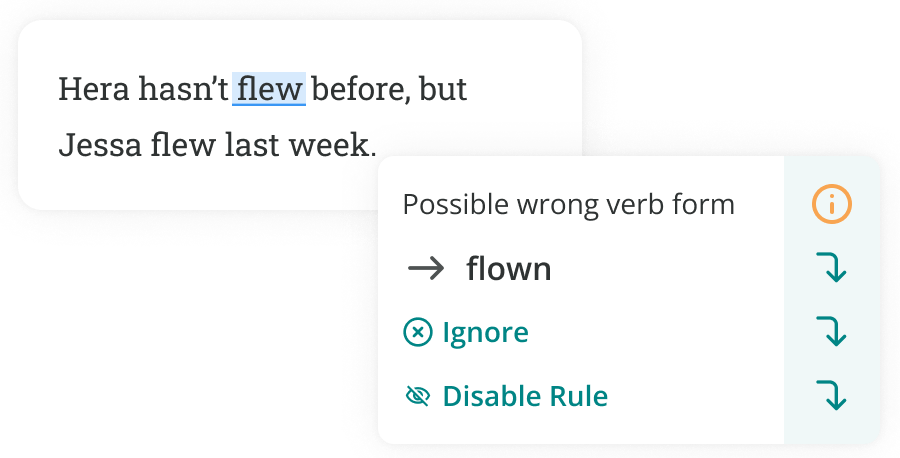
Irregular verbs are verbs that do not follow the normal pattern in their past tense or past participle. These verbs can make writing in English pretty tricky!
Fly is an irregular verb. The past tense of fly is flew, and the past participle is flown.
Fly is a commonly used verb, so it’s helpful to understand how to use its past tense forms. However, you can always use ProWritingAid’s free grammar checker to ensure you’re using the correct form of an irregular verb.
Let’s take a closer look at how to correctly conjugate the past tense and other forms of fly.
What Is the Past Tense of Fly?
When we talk about the past tense of a verb, we usually mean the simple past tense form. The simple past is how we refer to something that happened once in the past.
The simple past tense of fly is flew. Here’s what this looks like in a sentence:
- The pilot flew overnight from Paris to New York.
- The children flew a kite at the beach.
- We flew to Puerto Vallarta for our summer vacation.
Fly Past Participle
The past participle of a verb is the form used to construct the perfect tenses. There are three perfect tenses in English: past perfect, present perfect, and future perfect. Perfect tenses describe completed or to-be-completed events.
Often, the past participle of an irregular verb is different from its simple past form. This is the case with fly. The past participle of fly is flown.
Here’s what this might look like in a sentence:
- With all the layovers, I will have flown for forty hours.
- I have never flown a kite before.
- Have you ever flown on British Airways?
Past Perfect of Fly
The past perfect tense is used to talk about completed actions in the past. We construct the past perfect using this formula:
had + past participle
The past perfect tense for fly is had flown. Here are a couple of examples:
- I was exhausted because I had flown all night.
- The pilot had flown commercial jets for thirty years when he retired.

What Is the Future Tense of Fly?
The simple future tense of fly is will fly. But there is also the future perfect tense (will have flown), the future continuous tense, and the future perfect continuous tense.
We use the same present participle for past continuous tense, present continuous tense, past perfect continuous tense, present perfect continuous tense, future continuous tense, and the future perfect continuous tense.
The present participle of fly is flying.
Check out this table of all the forms of fly.
Fly Conjugations
| Simple Past | flew |
|---|---|
| Simple Present | fly/flies |
| Simple Future | will fly |
| Past Perfect | had flown |
| Present Perfect | has/have flown |
| Future Perfect | will have flown |
| Past Continuous | was/were flying |
| Present Continuous | am/is/are flying |
| Future Continuous | will be flying |
| Past Perfect Continuous | had been flying |
| Present Perfect Continuous | have been flying |
| Future Perfect Continuous | will have been flying |
Tips for Remembering Fly Past Tense and Other Verb Forms
The best way to remember irregular verbs is practicing and checking your work with a spelling and grammar checker. ProWritingAid is free to download and can detect grammar mistakes for you as you write.

It’s also helpful to have a good understanding of the main verb tenses in English. To remember how to use the past participle flown in perfect tenses, just think: You are perfect on your own.
Do you confuse past participles and past tenses? Let us know in the comments.


